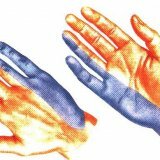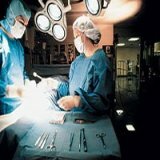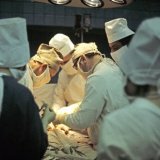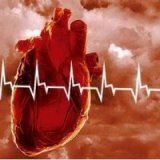Neuropathy of the ulnar nerve, treatment

Notable is the loss of sensitivity in the region of the little finger, and in addition to the ulnar end of the ring finger, as well as the elbow end of the palm. The superficial placement of the ulnar nerve in the elbow joint area creates its vulnerability during squeezing. A little lower may be squeezing the ulnar nerve in the elbow canal. Prolonged squeezing of the base of the palm, for example, when using hand tools or when riding a bicycle, can also be accompanied by a violation in the work of the deep branch of the ulnar nerve. As a result, begins to develop weakness of their own muscles, with a sensitivity disorder is absent.
Neuropathy of the ulnar nerve.
In the ulnar nerve, neuropathy provokes compression of the nerve in the elbow joint area, which occurs in people who work with elbow support on a workbench, machine, desk or even with prolonged sitting with arm seating on chair armrests. It is also possible to localize the compression of the ulnar nerve at the level of the elbow joint in the elbow groove of the median epicondyle or in the place where the nerve exits, where it is compressed by a fibrous arch that is stretched between the ulnar flexors of the wrist( so-called ulnar nerve syndrome).Isolated position of the nerve takes place in case of fractures of the inner humeral condyle and in the case of supracondylar fractures. The appearance of nerve compression can also occur at the level of the wrist. It happens that nerve damage can be observed in case of abdominal and typhus and other acute infections.
Consider the main symptomatology of neuropathy of the ulnar nerve. There is numbness, as well as paresthesia in the region of V and IV fingers, and also on the elbow end of the hand to the mark of the wrist. As the development of the disease is observed, there is also a significant decrease in strength in the region of the leading and withdrawing muscles of the fingers. In this case, the brush becomes like a "clawed paw".Because of the preservation of the function of the radial nerve, the main phalanges on the fingers are very strongly bent. Due to the preservation of the functions of the median nerve, the position of the middle phalanges is bent, the V finger is most often allotted. Also observed is hypoesthesia or anesthesia in the region of the ulnar half of IV, and also completely V of the finger on the side of the palm, and in addition IV, V and half of the third finger on the back of the hand. There is atrophy of small muscle tissue of the wrist - vermiform, interosseous, as well as the pinkies of the little finger, and also the 1st finger. To accurately make the diagnosis forced to resort to specialized methods: 1) during the compression of the hand in the fist, incomplete flexion of IV, V, and partially and III fingers;2) in the case of a brush that fits snugly against the table surface, it is impossible to scratch the table with a little finger;3) in the same position of the brush, it is impossible to bring and raise the fingers, especially V and IV;4) when the paper runs, it is not possible to hold the finger with one finger that is straightened, the phalanx of the end of the 1st finger is not flexed( a function that is performed by the long flexor of the 1st finger that is innervated by the median nerve).
Let us briefly consider what neuropathy of the ulnar nerve is, treatment and diagnosis.
We use massage, physical and physiotherapy, acupuncture, exercise therapy, muscle and nerve stimulation( physiotherapy removes pain and paresthesia, restores strength in the muscles of the hand during therapy of neuritis of the ulnar nerve).In the absence of recovery symptoms for 1-2 months, an operation is recommended( stitch the nerve trunk, neurolysis, etc.).
In case of occurrence of neuropathy of the ulnar nerve, it is recommended to perform the following actions:
- Press with a healthy hand on the middle phalanx on the fingers until they are perfectly straightened. Repeat the procedure must be done 10 times.
- In turn, lower and raise any of the fingers with a healthy hand( starting with the large and up to the little finger).Repetition - for 10 times.
- In turn, take away any finger with the help of a healthy hand, at the same time it is necessary to start with a large one. Repetition - 10 times.
- Produce each finger circular movements in two directions. Repetition - 10 times.
- Lower and raise 4 fingers( from the index finger to the little finger), straighten them in the main phalanxes. Repeat - 10 times.
- Raising the brush with a healthy hand and lowering, placing on the edge of the palm on the side of the little finger, then doing circular movements around the wrist joint opposite and clockwise, the brush holds the end of the three fingers - the middle, index, and also the ring finger. Repeat - 10 times.
- The brush is placed vertically with respect to the water on the fingers bent in the main phalanx, folding the fingers with a healthy hand in any phalanx and straightening. Repeat - 10 times.
- Put the brush on the bottom with bent and divorced fingers, straighten them with springy movements. Repeat - 10 times.
- Put a small towel or napkin in the water. We grab, we feel the napkin, we squeeze it in our hands, we move the bent fingers slightly on the napkin, moving simultaneously the base of the palm. Repeat - 10 times.
- Capture in water of rubber objects of different dimensions and squeezing them. Repeat - 10 times. As the movements are restored, they also make gymnastics more active, make complex movements: modeling of plasticine, capture of small items - nails, matches, peas, etc. Active movements with the help of a damaged arm are the same as in case of damage to carpalFingers.



